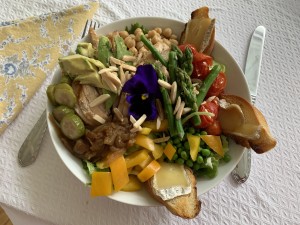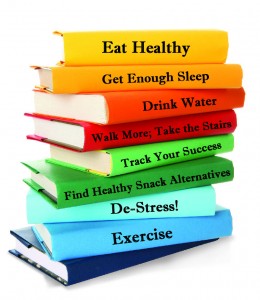- June 3rd: Walk 2 miles
- June 4th: Outside: 30 jumping jacks. 30 walking lunges.
- June 5th. 4 mile bike ride or 1 mile jog or 2 mile walk.
- June 6th Outside: 30 push ups. 30 squats.
- June 7th. Walk 3 miles
- June 8th. Outside: 10 minutes of super skaters
- June 9th. Bike 5 miles or jog 1.5 miles or walk 3 miles.
- June 10th. Outside: 10 minutes of skipping.
- June 11th. Walk 4 miles or jog 1.5 miles.
- June 12th. Outside: 20 jacks. 20 walking lunges. 20 bird dogs. 20 crunches
Monthly Challenge May 2019 – Strength and Core
-
Mon May 6 – 30 Russian twist
-
Tue May 7 – 30 Superman
-
Wed May 8 – 30 Crunches
-
Thu May 9 – 30 Bird dogs
-
Fri May 10 – 30 Bicycles
-
Sat May 11 30 – Push ups
-
Sun May 12 – 30 Swimmers
Monthly Challenge April 2019 – Legs and Diet
Leg and Diet Challenge for April 2019
- Day 1: 25 Walking Lunges. No sugar today.
- Day 2: 25 Squats. No bread today.
- Day 3: 25 Side to side squats. Eat a big salad today.
- Day 4: 25 Side leg lifts each leg. Drink 80 fluid oz water today.
- Day 5: 25 Back leg lifts each leg. Replace dessert with fruit today.
- Day 6: 25 Front leg lifts each leg. Eat only vegetables for snacks today.
- Day 7: 25 Step back lunges. Eat vegetarian today.
- Day 8: 25 Sit down and stand up. Drink no sugar drinks today.
- Day 9: 25 Lunge Pulses each leg. Do not eat after 6pm today.
- Day 10: 25 Plie Squats. No simple carbs today.
- Day 11: 25 Curtsey lunges. Drink 20 oz lemon water before breakfast today.
- Day 12: 25 Bottom half squats. Eat vegan today.
- Day 13: 25 Lunge kick. Drink only water today (and just 1 cup coffee or tea)
- Day 14: 25 Squat side leg lifts. Eat 1 meal of just raw food today.
- Day 15: 25 Lunge Switches. No dairy today.
Monthly Challenge March 2019 – Total Body
March Challenge: Total body
- Wed 20 push ups
- Thur 20 squats
- Fri 20 situps
- Sat 20 superman
- Sun 5 minutes run in place
- Mon 30 jumping jacks
- Tue 10 push ups. 10 squats
- Wed 15 crunches . 15 superman
- Thur 2 minutes little feet
- Fri 25 walking lunges
- Sat 25 bicycles
- Sun 5 minutes superskaters
- Mon 1 minute plank
- Tue 25 bird dogs
Repeat.
Monthly Challenge February 2019 – Core
- DAY 1 – 25 CRUNCHES
- DAY 2 – 1 MINUTE PLANK
- DAY 3 – 25 SUPERMAN
- DAY 4 – 1 MINUTE PLANK
- DAY 5 – 25 BICYCLES
- DAY 6 – 2 X 1 MINUTE PLANK
- DAY 7 – 25 RUSSIAN TWISTS
- DAY 8 – 1 MINUTE PLANK
- DAY 9 – 25 BIRD DOGS
- DAY 10 – 1 MINUTE PLANK
- DAY 11 – 25 REVERSE CRUNCHES
- DAY 12 – 2 X 1 MINUTE PLANK
- DAY 13 – 25 CRUNCHES OR SIT UPS
- DAY 14 – 1 MINUTE BACK PLANK
- DAY 15 – 25 SUPERMAN
Monthly Challenge January 2019 – 21 day challenge
Welcome to our Jan 21 day challenge!
This challenge is designed to be in addition to whatever fitness routine you currently follow, which is why it includes very reasonable sets of exercises, and includes things that we don’t often focus on in our daily lives such as nurturing relationships, reaching out to friends, trying new things and focusing on increasing hydration. You are encouraged to use this challenge as a springboard to build these things into your daily routine and in doing so it is the hope that you will feel better mentally and physically as a result.
Look out for encouraging emails throughout the 20 days, and feel free to let me know how you are doing and how this month’s challenge has been for you. Below is a reminder of your challenge:
Dancing with the Stars Live in Lowell!
Click the link below to see my Dancing with the stars video. I was at the live tour in Lowell, Ma and was selected as a volunteer to go up on stage and dance with them, thanks to my two friends Kathy and Nancy who screamed so loudly that I couldn’t fail to be selected! So much fun!

See video of Janine on DWTS live in Lowell, Ma
Nutrients and Nourishment
Nutrients and Nourishment

As I’m currently working towards a Fitness Nutrition Specialist Certification, I thought I would share some of the information I’m learning with you via these monthly articles. If we can become better informed about foods and nutrients, it should certainly empower us to make better decisions in our day to day eating and exercise habits. This first article is just a quick overview of our food and what it contains. In the coming months we will look more deeply into each of these elements to truly understand how our bodies use them.
First of all think about this? Do you eat to live, or live to eat? I have heard this question posed in regards to work – and in this context it is trying to ascertain the same thing. Are you focusing too heavily on the joy of eating versus the importance of good and healthy nourishment for your body.
Many things influence the way that we eat. Our age, gender, genetic make-up, lifestyle, family and cultural background affect our food choices. We use food to project an image, show our creativity, build relationships, show friendship and express feelings.
We eat to cope with stress, or perhaps we don’t eat when we are stressed. We eat as a reward when we have done a good thing, or we don’t eat as punishment for personal failure. It would be interesting to figure out specifically what dictates our food preferences, and then to compare that with what we should be eating daily for optimal health.
Our food preferences can begin very early in life. Experiences we have had as a child cause us to like or dislike a food, and that can carry all the way to adulthood. To some degree what you eat says a lot about who you are. Age is certainly a factor. Infants with wide exposure to various foods will usually try new foods whilst pre-school children usually have a fear of trying new foods. Contrastingly school age children begin to be braver about trying new things and teenagers tend to be influenced in their food choices by their piers.
Look at which foods appeal to your senses. Taste, smell and texture play a roll – some people dislike certain foods just based on the texture. Color, moisture and temperature can also play a roll. Some people prefer salty foods to sweet, and others the reverse. Cognitive influences come from learned food habits which can go back to childhood.
If we were to generalize, we would see that in the typical American diet the most common grain is white bread. The favorite vegetable is the potato (usually in the form of French fries), and beef seems to be the favorite protein. As a whole, Americans eat few fruits and whole grains, focusing more on cereals, snack foods, juices and sodas. It seems many Americans do not know what they should eat, and even when they do learn what to eat it doesn’t necessarily make a difference to their daily food choices.
Some other factors that effect food choices are:
Environmental – where do you live, hot or cold, you will choose different foods depending on the weather
Religion – many religions have rules in regards to foods not to be consumed, or certain times when foods are limited.
Culture – certainly the culture you are born into plays a part. If you are like me and were born in another country, you carry many of your food and beverage habits with you to the new country – I’m specifically thinking of my 4pm tea time which my husband has also adopted.
Lifestyle – this plays a large part. How much time do you have to cook? What foods are available at your workplace? Does your schedule cause you to resort to convenience foods, or do you eat out several times a week?
Economics – What types of food can we afford or not afford? It used to be the refined foods that were available only to the wealthy, and the poor folk grew what they ate and raised their own meat etc. These days things are flipped around to where the refined foods are the cheapest, and the organic and more healthful choices are much more expensive.
Our goal should be to focus first and foremost on nourishing our bodies for optimal health. We can do this in a way that will still allow us to enjoy eating and look forward to our meals, perhaps even more so. Nourishment is necessary for growth and development, for cell and tissue maintenance, to provide fuel for physical activities, and to properly regulate our body processes.
There are 6 classes of nutrients:
- Carbohydrates
- Proteins
- Lipids (fats/oils)
- Water
- Vitamins
- Minerals
These nutrients can be divided into organic and inorganic. Vitamins, carbohydrates, lipids and proteins are all organic and contain carbon in their biological structure, whereas water and minerals are inorganic with no carbon present.
- Inorganic nutrients: Water, minerals. Inorganic nutrients have a simple structure containing just one element
- organic nutrients: Fats, Proteins, Carbohydrates and Vitamins. Organic nutrients have more complex chemical structures. Carbohydrates, lipids and proteins are made of smaller building blocks and vitamins have an elaborate structure of compounds.
Foods generally do not contain just one nutrient, although we might consider meat a protein and bread a carbohydrate – we are really generalizing based on the fact that protein is the largest part of meat and carbohydrate is the largest part of bread. However, there are usually small amounts of a variety of nutrients in most foods. A lot of carbohydrates also provide our body with fiber which is not technically an essential nutrient, but is very important for our overall health.
The purposes of nutrients:
- To aid in body processes
- To contribute to cell and body structure
- To supply energy
Carbohydrates
Main dietary sources: (Plant based): Starches, sugars, grains, vegetables, dry beans, peas, legumes, fruits.
Main purpose of carbohydrates: To provide your body with energy.
If thinking of water makes you think about hydrating, then the word carbo-hydrate tells you the exact composition of this nutrient. Carbohydrate is made up of Carbon, hydrogen and oxygen and is an important source of fuel for the body.
Carbohydrates are converted in the body to glucose, a simple sugar compound. Glucose is what our body uses to provide energy for cells and tissues. Carbohydrates provide the body with it’s preferred energy source. In the absence of enough carbohydrates it can use fats and proteins, but using alternative energy sources can deplete our bodies since fats and proteins have other important jobs that will be neglected if they are called upon to become a carbohydrate ‘stand-in’!!
Fats (Lipids)
Main dietary sources: Fats and oils, natural fats found in meat and fish, dairy products and other less obvious plant sources such as avocado and coconut, olives, nuts and seeds.
Main purpose of fat: The body uses fat as a fuel source, and fat is the major storage form of energy in the body. Fat also has many other important functions in the body, and a moderate amount is needed in the diet for good health. Fats in food come in several forms, including saturated, monounsaturated, and polyunsaturated.
Lipids are substances known as fats and oils. But they can also be fat like substances in foods such as phospholipids, and lipoproteins. Fats are organic compounds containing carbon hydrogen and oxygen.
Another type of fat: triglyceride. Triglycerides are a type of fat (lipid) found in your blood. When you eat, your body converts any calories it doesn’t need to use right away into triglycerides. The triglycerides are stored in your fat cells. Later, hormones release triglycerides for energy between meals. Triglycerides are an important fuel source for the body. Also triglycerides, lipoproteins and phospholipids have other important jobs in the body, such as providing structure for body cells, carrying fat soluble vitamins and providing cholesterol. Our bodies need cholesterol for important metabolic processes but we don’t need to consume it, our body can make enough using other compounds. Of course we all know that too much blood cholesterol is not good for us so we need to keep it all in balance.
Proteins
Main dietary sources: Meat and fish, nuts, dairy products, Soy
Main purpose of protein: Hair and nails are mostly made of protein. Your body uses protein to build and repair tissues. You also use protein to make enzymes, hormones, and other body chemicals. Protein is an important building block for bones, muscles, cartilage, skin, and blood.
Proteins are organic compounds made of smaller building blocks called amino acids. Unlike carbohydrates and fats, amino acids contain nitrogen as well as carbon, hydrogen and oxygen. Some amino acids also contain sulfur. The amino acids you get from protein combined with those in the body to make hundreds of different body proteins. We can divide these proteins into two groups:
- Structural proteins: Build and maintain body structures
- Functional proteins: Regulate body processes
Vitamins
Vitamins are organic compounds that contain carbon, hydrogen and sometimes nitrogen, oxygen, phosphorus and sulphur. Some vitamin functions in the body include:
- Regulating body processes such as energy production, blood clotting and calcium balance.
- Keeping organs and tissues healthy.
- Extracting energy from carbohydrates, fats and proteins.
Vitamins divide into two groups: fat soluble and water soluble.
Fat soluble: A, D, E and K. Fat soluble vitamins can be stored in larger amounts in the body, and are all transported in the same way.
Water soluble: C and 8 B vitamins: Thiamin(B1) Riboflavin(B2) Niacin(B3) Pyridoxine(B6) Cobalamin(B12) Folate, Pantothenic acid and Biotin. Most interact with the energy metabolism pathways.
Vitamins are in a variety of foods. If you have a balanced diet you will get enough of each and can rarely overdose on any. But if you overdo supplementation, some vitamins can become toxic and cause serious issues.
Minerals
Minerals are inorganic substances. 16 essential to health:
Microminerals:
- Iron
- zinc
- copper
- manganese
- molybdenum
- selenium
- iodine
- fluoride
Minerals have diverse functions:
- Structural roles – calcium phosphorus, fluoride
- Regulatory roles – control of fluid balance, muscle contraction
Water
Water chemically the simplest nutrient. While we can live sometime without food, we cannot live long without water. 60% of our body is water so it is essential. Water is used for:
- Temperature control
- Lubrication of joins
- Transportation of water soluble vitamins and waste
Sources of water: Water itself is our best source. We should drink about half of our body weight in fluid oz per day, not including any we sweat out. We also gain some hydration from beverages, fruits and vegetables
Energy sources:
Carbohydrates, Proteins, Lipids (but only as triglycerides)
- Carbohydrates = 4 Cal/gram
- Protein = 4 Cal/gram
- Fat = 9 Cal/gram
- Alcohol = 7 Cal/gram
Sorting fact from fiction
Finally, I’m sure you are constantly hearing of new claims regarding the healthfulness or lack thereof of certain foods, the latest fad diet etc… the media is very good at overstating any new finding that is out there. All this contradicting information can be very confusing. How do we sort out the scientific facts from so much misinformation? First of all consider the source. Usually news stories are sensationalized, over simplified, facts are distorted, omitted or modified. Also beware of anything that has the following claims:
- Quick fix
- Dire warnings of dancer
- Claims that are too good to be true
- Simplistic conclusions
- Dramatic statements
There is still much to learn about food and its healthful properties. As scientists continue to conduct studies we will find out more about things that are helpful and harmful and as we learn we will adjust as we have always done. Just remember this, what you eat really does matter. Your diet will likely effect your quality of life and ultimately could effect the length of your life. Making good and healthful daily choices will give you the best chance to live a long and healthy life, continuing to do all the things you love.
New Year’s Resolutions
Turn your New Year’s Resolutions into SMART Goals
New Year … New You!

Christmas is over, and now it’s time to think about the new year. That’s the time of year when we all tend to begin thinking about what we would like to accomplish in this new year, and what we would like to leave behind us. Usually we are looking to get rid of bad habits and pick up some good habits, but often this is easier said than done. Here are some helpful hints to get you started on that New Years resolution:
You may have heard of SMART goals. Specific goals. Measurable goals. Attainable goals. Relevant goals. Timely Goals. The acronym just helps to organize our thoughts in a way that can allow us to move towards the things we want to achieve in a realistic way.
1. SPECIFIC. Make a list of SPECIFIC things you would like to accomplish. For example:
- Lose 25 1bs by the end of 2019.
- Give up smoking by the end of 2019
- I will no longer be stressed
- Find a new job
These are your end goals, they are specific and not vague.
2. MEASURABLE. You have to be able to measure your progress and see that you are continually and successfully working towards your goals. For example, working towards your weight loss goal is MEASURED by weigh ins that show you are losing weight. You can MEASURE your smoking habits based on decreasing how much your smoke regularly and consistently until you are ready to stop altogether. Becoming less stressed can be measured by your general state of mind improving week by week. Taking steps towards finding a new job is evidence that you are working towards this goal. When thinking about how measurable your goals are, is where you begin to break down specifically HOW you are going to get from where you are now, to where you want to be. For example:
- To lose 251bs in a year you need to: change your eating habits, begin an exercise regime.
- Next take steps towards those things. Enroll in an exercise program, begin a new eating regime.
- To stop smoking: Begin to reduce cigarettes daily, set a date when you will stop and use the patch or some other form of smoking cessation help to stop completely.
- To decrease stress identify what stresses you out, and try to change those situations.
- To find a new job you just need to begin looking or interviewing.
3. ATTAINABLE. Your goals have to be realistic and attainable. You don’t want to give yourself an impossible task by an unrealistic date, and set yourself up to fail. Be sure that what you are setting out to do is possible.
4. RELEVANT. Your goal has to be something that is worthwhile. Something that you are willing and able to work towards and once achieved will be worth the effort.
5. TIMELY. Above all you should impose time constraints on your goals. Rather than leaving them open ended make sure you have a time schedule attached to each goal. Setting a deadline will give you motivation and a sense of urgency in achieving your goals.
perhaps you want to share your goals with a friend, or you and a friend share your goals with each other and have regular check ins to see how you are doing working towards each goals. Accountability can go a long way towards maintaining motivation as you move forward toward your goals.
How to live your best life and be your best self

Do you love your life? Do you enjoy every moment of every day? Do you look around you and feel how blessed or lucky you are? If not, why not?
Conversely, do you wish the days and weeks away until the weekend, or the vacation, or the summer? Do you find you have more things to complain about than to be thankful for? Do you have a negative self image?
What happens if life hands you lemons? Do you make lemonade?
Being a strong and healthy person involves much more than diet and exercise. In order to live your best healthiest life and to be your best and healthiest self you have to ask yourself a few important questions:
- What are the things in my life that really make me happy?
- What are the things in my life that make me unhappy or cause me stress?
- What changes can I make in my life that will make me happier?
Answering these three questions will help you start to find the path towards a happier, healthier and more fulfilled life.
There might be some things in your life that don’t make you happy but that you can’t change, so the alternative is to try to adjust them in such a way that they become less stressful and more tolerable. Increasing the positive aspects of your life will inevitably help to decrease the negatives. Also adjusting your mindset, or the way you think about something can go a long way toward helping adjust a negative situation into a more positive one. Back to the saying ‘if life gives you lemons, make lemonade’.
If I made a list of the things that make me happy it would be a very long one! Over time I have adjusted things in my life to the point that I really love my everyday life, and there are very few negatives.
In order to live your best, happiest, healthiest and most fulfilled life you have to be able to say ‘no’. Say ‘no’ to those things that will cause you stress and take time away from those things that you truly enjoy and love.
Here is a little formula to get you started:
First, list the things that you may either love about your life, and the things that make you feel good and happy. Here are a few examples:
- Your children/grandchildren
- Your spouse/partner
- Specific hobbies ie. Tennis, scrapbooking, cooking.
- Volunteering
- Workouts at the gym
- Eating healthy foods
- Losing weight
- Feeling stronger
- Specific friends who make you feel positive
Second, list the things in your life that cause you unhappiness or stress or that you don’t like. Here are a few examples:
- Work – be specific if it’s something at work or the whole job itself
- People – who in your life has a negative influence, causes stress
- Juggling too many things – be specific (volunteering, other commitments)
- Cleaning/washing/yard work
- Your hair style
- Negative body image
- Family relationships
- Lack of close friends, community
- Unhealthy eating
- Lack of time for yourself
- Lack of exercise
- Negative self image
- Lack of sleep
Third, make a list of things you can change for the better realistically. Here are a few examples:
- Plan more exercise into my week
- Buy healthier foods and work on eating better and less
- Go to bed earlier
- Get a new hair do, get a facial
- Join a church or a community group
- Make time for myself
- Hire a cleaner or Gardner
- Get rid of excess volunteering that takes time from family & increases stress
- Assign meals to different family members to reduce burden on me
- Actively work to improve negative family relationships
- Job – can I change jobs or improve my current situation
- People – spend more time with the people who encourage you and make you feel good about yourself and your life. Or those who give you good advice and are always in your corner. Conversely, if there are people in your life who cause you stress, then perhaps it’s time to let them go. Surrounding ourselves with negative people will tend to make us feel more negative ourselves
Forth, make a list of the things that you cannot change but can improve upon. For example:
- My job. Think of ways to improve your time at work if you can’t change jobs. Perhaps go part time, or think of other ways to improve your work day.
- If you have small children (which can be stressful), perhaps you can hire a sitter to take some time for yourself to exercise, go out with friends or your husband, or go get a massage. Try to make it a weekly occasion.
- People. If the people who cause you stress are family members or work colleagues, perhaps try to lessen your contact with them where possible, or actively work on influencing them in a positive way rather than allowing their negativity to rub off on you.
- Daily responsibilities. If you hate cleaning but cannot afford to hire a cleaner then maybe spread out the responsibilities to other family members, or try to make cleaning day a fun experience.
Fifth, take steps toward making the changes you have listed. Do it slowly and step by step you will find yourself feeling better, healthier and happier. The test is to ask yourself a few simple questions:
- When you wake up in the morning, are you looking forward to your day?
- Are you thinking good and positive thoughts throughout the day?
- Are you spreading positivity to those around you?
- When you go to bed at night do you feel good about your day?
- Do you sleep well?
- Do you feel overall healthier and happier?
Of course there are going to be those things that occur in daily life to cause us stress, aggravation and sadness. These types of feelings come and go, and if your overall daily life is a healthy and happy one, you will more quickly recover from the temporary setbacks that life often brings. I find that our perspective has a lot to do with how we deal with life’s unexpected stresses. Knowing that we are still so much better off than others in the world can often help us adjust our attitude, and make lemonade out of those annoying lemons.
I do feel that in every difficult situation there is something positive to be learned, even if it just helps us to grow and become stronger as a person.
In conclusion, I challenge you to take a close look at every aspect of your life. Make the changes necessary to allow you to be your healthiest and happiest self. We are only here for a short time, and we shouldn’t take any of it for granted. Spread positivity to those around you, and live and love every day to the max.
